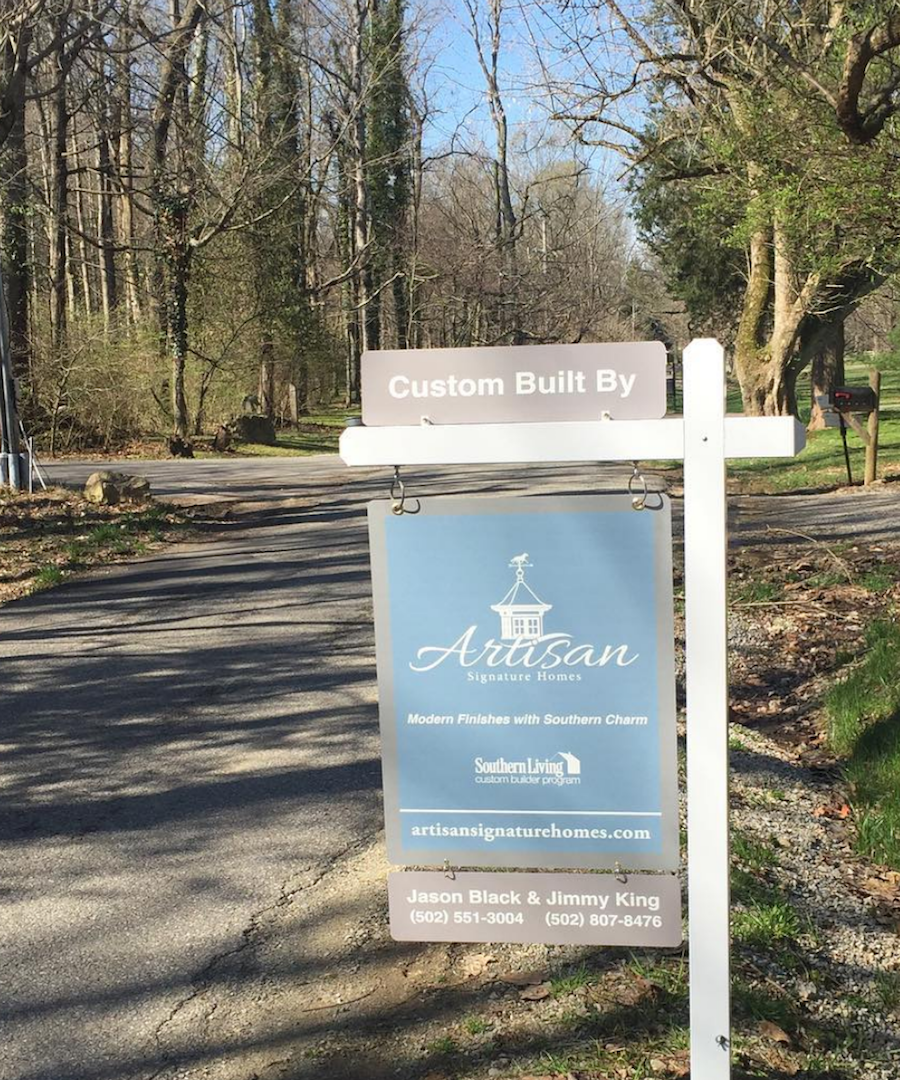
26 Sep Preparing Building Lots For Your Custom Home Construction
Transcript: Welcome to this edition of the Louisville Custom Home Builder podcast series, brought to you by Louisville’s leading luxury construction team, Artisan Signature Homes. I’m Greg, your host, and, for today’s episode, we are joined by Louisville’s best-known and most accomplished custom and luxury home builder, Jason Black. Jason, nice to see you. How are you today?
Jason: Doing well. Happy fall to you, Greg.
Greg: That’s right, it is fall. It’s nice out. Thank you very much. I think this is almost a year now you’ve been doing your Podcast, we’ve talked about all sorts of finish homes and all sorts of finishes. I’m not sure we’ve ever touched on the very beginning of building and what it’s like to start with an empty piece of land. Maybe we can work backwards today?
Jason: Yeah. We get so caught up, and everybody gets thinking about the pretty images and the pretty kitchens that you don’t think about how do you actually get started with something like that.
One of the biggest things to start with, and people always ask me all the, “Well, what comes first? Do you, do you pick the lot first or do you have a design and then you go find the lot?” We’re going to defunct all those rumors today and get to the bottom of it.
Greg: I’m guessing you’ve done it both ways. Is there a best or is it really depending on the client and which is most important to them?
Jason: My preferred way is for a client to come meet with me. We will then find them a lot or, if they have a lot, they can come to me, but then, absolutely, getting the lot is the first step. Once you have the lot, it’s at that point that we will start designing the house plan because we can really take advantage of certain … Certain lots have different views and the sunsets in one direction or the other, so, by having the lot, we can really set the house appropriately to take advantage of the surrounding spaces.
Greg: You’ve talked several times before about sort of having an interview process. Not sort of, you do have an interview process. Is that part of it, trying to figure out where the light should come from? Are they going to want a wide house or a long house or a tall house? And you already know what kind of house fits on what kind of lot and where that might best exist?
Jason: Yeah, and, sometimes, you got to talk to the client or the customer first to understand, Do they want a ranch? Do they want a 2-story? Do they want a pool? Do they want to walk out? We really have to hone in on the specifics of that particular customer and then that may guide us to one lot of the other.
Greg: It may be even a subdivision or another?
Jason: Yeah. Some people may want a subdivision and some people don’t want a subdivision, want to have 20 acres, and you can put the house wherever you want.
Greg: Yeah, that would remove a few challenges if there’s a big piece of land and it’s, “All right, what are we drawing up?”
Jason: It does, but one of the challenges when you have a big piece of land is how do you position the house because it’s a struggle when you can put the house anywhere, it’s like, “Oh, where do I want to put it? Where do I want to face it?”
Greg: Too many choices?
Jason: Too many choices sometimes can be bad, that’s why building in a traditional neighborhood of Norton Commons a lot of times, there’s really one right way to put the house, and that’s where it’s going to go.
Greg: That’s an interesting way to think about it. I had not thought about that problem of too many choices in a lot, but I can see them in some of the bigger pieces of land I’ve seen you build on. You could put it in any number of different places and turn it into any number of different ways and approach it, literally, via a car or driveway, whatever, a countless number of ways.
Jason: That’s right. We’ll talk through those options. The good thing is, once you’ve identified a lot, there are a lot of restrictions and setbacks that you have to follow, so some people … I learned the hard way. When I built my first house, I didn’t know anything about setbacks, so I designed the house that was too wide for the lot. I didn’t take into account that, “Hey, I actually need 25 feet for a driveway turnaround and, oh, by the way, on the opposite side, you have to be 5 feet or 10 feet off the property line,” so I ended up with a house that was about 5 feet too wide. It crushed me because I had to shrink it, and I did not want to shrink it. I’d already had the perfect house design so…
Greg: When in the process did you catch that one?
Jason: When I was finished with the design of the house. I went to send it to the surveyor, and he sent it back and he’s like …
Greg: It’s pretty, but…
Jason: … “Jason, your, your driveway, you got a golf cart or a smart car because, your SUV is not going to fit in that garage?!”
Greg: Wow, but at least it wasn’t built.
Jason: That’s right, and it was for myself. I was a good test market, and I learned a valuable lesson, so that’s what the luxury of building a couple hundred homes over the years is. You learn by mistake, unfortunately. I’ve paid a lot of dues over the years.
Greg: All right, so I’m curious about the process once you have the lot picked out how a house actually starts to develop on the land. I mean, I think everyone’s driven by a construction zone where there’s a huge hole in the ground, and I’ve never quite understood how you actually … how are things squared up and measured and … I mean, I assume someone doesn’t just drive out there with the equipment and start digging willy-nilly. Can you walk me through the beginning of a house?

Jason: Yeah, so I’m going to fast forward. Assuming we have a house plan that we’ve already designed, and then we’ve signed the contract, we’re ready to break ground, so, at that point, we’ll use one of our professional engineers to actually come out and do a survey of the property. We’ll stake the property corners and then we’ll actually stake the house on there, and they are … It is a perfect … obviously, there’s some room for error, but these engineers are very precise. We’re staking to the, I don’t want to say to the inch, but the 16th of an inch. I mean, everything is spot on.
Greg: This would be like the corners of the house?
Jason: Yeah, the house corners, porch corners, and I guess, really, we kind of jumped ahead, assuming there’s no trees on the land, if you have a wooded lot…
Greg: Yeah, let’s step back actually and talk about how you figure out … You build or design the right house when you have the lot. I didn’t even ask about lot preparation. What do you do to get ready to even think about breaking ground?
Jason: One, you’ve got to get a permit and get your local subdivision or city to approve it, and county, all those proper protocols and get your permit so we can actually break ground. Once you have your permit, you will get your excavator or your land clearer out there. Sometimes, we’ll have to rough-stake the house corners. If we have a heavily wooded lot, you don’t want to come in and just destroy every living tree out there.
There might be some great trees you want to work around, so, if that’s the case, it’s kind of more of a detailed step process, but staking those house corners, we’ll then get our clearing company in there, and we’ll kind of tag everything that’s going to be in the way of the house. Usually, within 10, 15, 20 feet of the house, you don’t want any large trees because, within time, that root system is going to fail, so we’ll clear out all those, try to keep what we can and maybe, while we’re out there, clearing a lot of times the tree clearing company will clear up the backyard and just really get the site prepared for somebody to live there.
Greg: You said, “Keep what we can.” Is that because that’s your choice that you like to have trees around or is that usually the client likes to have trees around, or is it just it’s a good thing and there’s nothing wrong with keeping as many trees as possible?
Jason: Usually, it’s both. I mean, I like to keep trees any time we can, especially … A lot of times, people, when they drive through, like we’re doing some work in Anchorage and we’re doing some work in Glenview, and people are always attracted to those areas and, sometimes, they don’t know why, but I think a lot of times it’s the mature trees. It really gives a neighborhood some maturity that makes it feel like home.
Greg: Is that another reason you like to pick the lot out first before designing the house because … would you work and design around existing trees on a lot?
Jason: Yes. Yes. Our engineer sometimes will go out to the lots, and we will pinpoint on the lot all the big trees they want to keep, and then we can design the house around it. We’re doing some work in Poplar Woods right now, and we did the same things. We pinpointed some big trees on there and we’ve altered plans to accommodate those larger trees. It may be foregoing a circle drive or adjusting where the garage is or pushing it back, but, yeah, absolutely, we’ll work around big trees.
Greg: Okay, so then you were telling me about the engineers and the survey coming out and …
Jason: Yeah, so, once we’ve cleared the trees, the lot is ready, we’ll have usually a temp pole out there for some electricity for the gas to work off of. At that point, the engineer comes back in. We’ll stake all the house corners. Usually, we’ll stake all the corners. We’ll stake the porches. We’ll stake where the garage is going to be, stake the front property and back properly lines. All that is staked, and then we will actually call BUD, Before U Dig, and have our excavator come out at that point, and we will be ready to actually break ground. He comes out, brings his big high lift tractor out there, usually one. Sometimes, we’ll bring two on some of the larger houses we do, and we’ll start digging.
Before we get too far, we’ll actually have to do what’s called, we’ll establish grade. One of my big pet-peeves is I love curb appeal. I like a house to sit above the curb, so, really … so, when you drive by, you’re looking up to the house. I don’t ever like to set a house below the curb. Some of these big fallout lots, you’ll see houses below the curbs or … It just, one, it invites water in to the foundation and, two, it’s just not visually appealing. I’m kind of a snob when it comes to placing a house and I like it to sit up nice and pretty.
Greg: I would hope that everyone would want their home builder to be something of a snob when it comes to houses.
Jason: That’s right. Many a times, we’ve staked and re-staked and adjusted grade just to make sure we get the proper foundation height so…
Greg: I have a picture of you in my mind driving around town, your parents driving around, and you’re in the backseat of your car looking out the window, like giving houses the thumbs down if it’s the … It’s like, “I don’t like that curb appeal.” The 10-year-old Jason Black is like, “Boo.”
Jason: With having 3 boys and spending … They spent tons of time with me in the car looking at houses, they’ve kind of picked up on it. They’re like, “Dad, did you see that house?” They’re like, “Ooh.”
Greg: Rolling judges, that’s awesome.
Jason: That’s right. That’s right, so … but they’re also complementary, too. We teach it both ways.
Greg: Wonderful. Okay, so you picked the orientation I guess of the house so that it … You like your curb appeal, and you’re digging away. How do those guys know when they’ve dug deep enough or wide enough?
Jason: Part of setting the grade is usually you want that foundation wall to be a minimum of a foot above what’s going to be your finish grade and, sometimes, 2 to 3 feet, again, all depending on the lot and what you’re going for. We’ll bring out a transit, and, usually, they’ve got … Our foundation company actually has a pretty complicated system. It’s all tied to GPS and, where he goes with the little stick, it will tell you how far above grade you are, but most of the guys aren’t going to spend 25-30 grand for that equipment, so our foundation guy has just a simple laser level and a large tape measure. If you’re ever out on the job site, he’ll have a 10-foot extension measure on a yardstick that’ll extend to about 20 feet.
What we’ll do is we’ll establish the high point of the lot and figure out from that point how deep do we have to dig. We do a lot of 10-foot basement walls, so, with that, you’ve got to have a like a foot for the footer. The footer is the first thing that gets poured and then the wall sits on top of that. We have to take into account the footer as well, so, usually, that’s taking an extra foot depth, and we’ll just establish grade and, once we do, we’ll paint some markers on the side of the dirt all the way around the basement and kind of work our way down there and make sure we’ve got the basement floor nice and level once we’re done excavation. Always, once you start digging, you’re hoping that you’re not going to hit rock.
Greg: Because that becomes another issue in and of itself, right?
Jason: It does. You always are happy once you get to the bottom of the basement and there’s no rock. We do have a fair amount of limestone here in Louisville, but, usually, it’s … a lot of them can be floater boulders or whatnot that you can scoop out with the high lift. Sometimes, you’ll have to bring in a big trackhoe with a hammer on there and knock out the rock to get the basement level.
Greg: There’s already a lot going on, it sounds like, pretty sophisticated stuff before really anything gets positively built, before any real construction happens.
Jason: Yeah, a lot of times, people drive by and, all of a sudden, the house is framed up. They’re like, “Oh, that went up fast,” but, usually, it’s … for me, it’s 6 to 9 months of work that’s gone into a project before you see framing go up. The foundation is definitely crucial in getting that in and, a lot of times, people don’t even take note until framing really starts to happen.
Greg: Okay. We’re already coming up on the end of time here. I don’t know if you want to keep going and talking about the foundation walls and basement walls and sump pumps and all that or if that’s another episode altogether?
Jason: Why don’t we wrap up on this and maybe next week we can roll in to kind of what goes into the preparation of the foundation to make sure you have got a good, sturdy foundation and, most importantly, a dry basement.
Greg: Absolutely, always a good idea. Thanks for having me out.
Jason: All right, Greg, take care.



